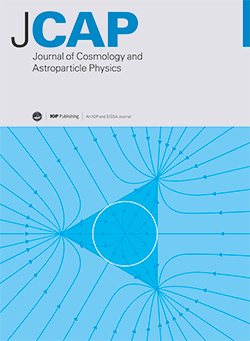希格斯入口向量暗物质在低再加热温度
IF 5.3
2区 物理与天体物理
Q1 ASTRONOMY & ASTROPHYSICS
Journal of Cosmology and Astroparticle Physics
Pub Date : 2025-06-18
DOI:10.1088/1475-7516/2025/06/040
引用次数: 0
摘要
我们研究了在再加热温度较低的情况下,具有希格斯-入口型相互作用的矢量暗物质(DM)的产生,这种再加热温度可以通过暴胀后暴胀的长时间衰变来实现。我们让再加热温度足够大,以符合标准宇宙学中的观测结果,如大爆炸核合成,但又足够小,低于DM质量,以产生DM。我们分析了模型参数包括额外规范耦合和再加热温度对DM遗迹密度、对撞机边界以及DM直接和间接检测实验的影响。我们的研究结果表明,DM质量(MWD)与再加热温度(TR)之间存在很强的相关性,其比值约为TR/MWD ~ 0.1,以获得用于检测相互作用强度的正确DM密度。衰变过程对于DM的产生通常是次要的,但当运动学允许且DM质量接近希格斯质量的一半时,它们可能很重要。DM质量低于100 GeV时,DM的产生主要是由SM费米子的散射和希格斯衰变驱动的,而DM质量较高时,DM的产生主要是由希格斯散射驱动的。在我们的框架中,强冻结的增强耦合使得在直接和间接检测以及对撞机实验中具有潜在的检测前景。目前的直接探测实验已经对模型的参数空间进行了部分探索,未来的达尔文等实验还可以进一步探索模型的参数空间。另一方面,当前和近期的间接检测实验不够灵敏,无法检验我们的模型。本文章由计算机程序翻译,如有差异,请以英文原文为准。
Higgs-portal vector dark matter at a low reheating temperature
We study vector dark matter (DM) production with Higgs-portal type interactions in the scenarios with a low reheating temperature which can be realized by a prolonged decay of the inflaton after inflation. We take the reheating temperature to be large enough to match the observations in Standard Cosmology such as Big Bang Nucleosynthesis but small enough below the DM mass for the DM production. We analyze the impact of the model parameters including the extra gauge coupling and the reheating temperature on the DM relic density, collider bounds and DM direct and indirect detection experiments. Our results reveal a strong correlation between the DM mass (MWD) and the reheating temperature (TR) with ratio of around TR/MWD ∼ 0.1 to obtain correct DM density for detectable interaction strength. The decay processes are generally subdominant for the DM production but they can be important when kinematically allowed and the DM mass is close to half of the Higgses mass. The DM production with DM masses below 100 GeV is driven primarily by the scatterings of the SM fermions and Higgses decay whereas the case with higher DM masses is achieved mainly due to the Higgses scatterings. The enhanced coupling for the strong freeze-in in our framework enables potential detection prospects in direct and indirect detections and collider experiments. The parameter space of the model has already been explored partly by the current direct detection experiments and it can be explored further by future experiments such as Darwin. On the other hand, the indirect detection experiments in the current and near future are not sensitive enough to test our model.
求助全文
通过发布文献求助,成功后即可免费获取论文全文。
去求助
来源期刊

Journal of Cosmology and Astroparticle Physics
地学天文-天文与天体物理
CiteScore
10.20
自引率
23.40%
发文量
632
审稿时长
1 months
期刊介绍:
Journal of Cosmology and Astroparticle Physics (JCAP) encompasses theoretical, observational and experimental areas as well as computation and simulation. The journal covers the latest developments in the theory of all fundamental interactions and their cosmological implications (e.g. M-theory and cosmology, brane cosmology). JCAP''s coverage also includes topics such as formation, dynamics and clustering of galaxies, pre-galactic star formation, x-ray astronomy, radio astronomy, gravitational lensing, active galactic nuclei, intergalactic and interstellar matter.
 求助内容:
求助内容: 应助结果提醒方式:
应助结果提醒方式:


